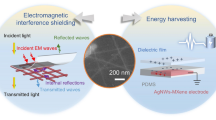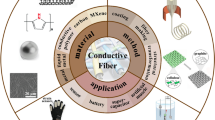Abstract
The major problem in the fabrication of electronic devices on plastic substrate arises from the mismatch and weak physical bonding between inorganic semiconductor crystal and the organic plastics, so the electrical performance stability under mechanical stress is an essential factor affecting the practical application of flexible electronic sensors. In this paper, a flexible ZnO nanowire (NW) UV sensor is presented as an exemplary verification for investigating the effects of substrate morphology on reliability of flexible electronic devices. Sensors on ordinary smooth polyimide (PI) substrate have cracked during the device fabrication process due to the residual stress caused by temperature, humidity, etc. These cracks were short pieces and randomly distributed, so they may not significantly affect the device performance, but after mechanical bending, cracks that penetrating the electrodes were generated and caused electric contact failure. Although improving the ZnO seed layer quality could reduce the cracking and buckling that formed during device fabrication, it would not prevent cracking during mechanical bending. In a 3 × 3 sensor array, only one sensor survived after bending. Device failed when the bending angle larger than − 40° or 60°. On the contrary, device fabricated on textured PI substrates exhibited much better electrical stability. All the sensors remained their original performances after mechanical bending in a 3 × 3 sensor array. The light–dark current ratios kept in the level of 105 under the 365 nm UV light of 15 mW/cm2. The bending angle varied from − 80° to 80°. The enhancement of electrical stability was because that textured substrate could tolerate more stress than smooth substrate to prevent the film from cracking and at the same time it could increase the contact area between ZnO film and PI substrate, which improved the interfacial bonding strength and delayed the local strain of the film.











Similar content being viewed by others
References
Lim S, Um DS, Ha M et al (2017) Broadband omnidirectional light detection in flexible and hierarchical ZnO/Si heterojunction photodiodes. Nano Res 10(1):22–36
Jin J (2006) Displays develop a new flexibility. Mater Today 9(4):46–52
Song J-K, Son D, Kim J et al (2017) Wearable force touch sensor array using a flexible and transparent electrode. Adv Funct Mater 27:1605286. https://doi.org/10.1002/adfm.201605286
Hou L, Hou Q, Mo Y et al (2005) All-organic flexible polymer microcavity light-emitting diodes using 3 M reflective multilayer polymer mirrors. Appl Phys Lett 87:243504. https://doi.org/10.1063/1.2119416
Mayer AC, Scully SR, Hardin BE et al (2007) Polymer-based solar cells. Mater Today 10(11):28–33
Bharti D, Raghuwanshi V, Varun I et al (2017) Effect of UV irradiation on solution processed low voltage flexible organic field-effect transistors. Superlattices Microstruct 109:538–544
Bai Z, Fu M, Zhang Y (2017) Vertically aligned and ordered ZnO/CdS NW arrays for self-powered UV–visible photosensing. J Mater Sci 52(3):1308–1317
Bai Z, Zhang Y (2016) Self-powered UV–visible photosensors based on ZnO/Cu2O NW/electrolyte heterojunctions. J Alloy Compd 675:325–330
Chan WN, Kim JH, Kim HJ et al (2017) Highly selective and sensitive detection of NO2, using rGO–In2O3, structure on flexible substrate at low temperature. Sens Actuators B Chem 255:1671–1679
Chao J, Xing S, Liu Z et al (2018) Large-scale synthesis of Bi2S3 nanorods and nanoflowers for flexible near-infrared laser sensors and visible light photosensors. Mater Res Bull 98:194–199
Lewis J (2006) Material challenge for flexible organic devices. Mater Today 9(4):38–45
Cai C, Ma Y, Jeon J et al (2017) Epitaxial growth of large-grain NiSe films by solid-state reaction for high-responsivity photodetector arrays. Adv Mater 29:1606180. https://doi.org/10.1002/adma.201606180
Fan Z, Ho JC, Jacobson ZA et al (2008) Large-scale, heterogeneous integration of nanowire arrays for image sensor circuitry. Proc Natl Acad Sci USA 105(32):11066–11070
Feldbauer G, Wolloch M, Bedolla PO et al (2015) Adhesion and material transfer between contacting Al and TiN surfaces from first principles. Phys Rev B 91:165413. https://doi.org/10.1103/PhysRevB.91.165413
Doerner MF, Nix WD (1988) Stresses and deformation processes in thin films on substrates. C R C Crit Rev Solid State Sci 14(3):225–268
Xiang Y, Li T, Suo Z et al (2005) High ductility of a metal film adherent on a polymer substrate. Appl Phys Lett 87:161910. https://doi.org/10.1063/1.2108110
Yin ZP, Huang YA (2016) Micro nano manufacturing. Science Press, Beijing
Xu W, Yang JS, Wang F et al (2011) Ductility of polymer-supported metal films with curved interfaces. Chin J Solid Mech 32(1):1–9
Xu S, Lao C, Weintraub B et al (2008) Density-controlled growth of aligned ZnO nanowire arrays by seedless chemical approach on smooth surfaces. J Mater Res 23(8):2072–2077
Calleja JM, Cardona M (1997) Resonant Raman scattering in ZnO. Phys Rev B 16:3753–3761
Gruber T, Prinz GM, Kirchner C et al (2004) Influences of biaxial strains on the vibrational and exciton energies in ZnO. J Appl Phys 96(1):289–293
Chen S, Pan X, Xu C et al (2017) Epitaxial growth and stress analysis of Zn1−xMgxO films on (111) Si substrates. Thin Solid Films 628:50–53
Guduru PR, Chason E, Freund LB (2003) Mechanics of compressive stress evolution during thin film growth. J Mech Phys Solids 51(11–12):2127–2148
Vlassak J, Wagner S (2005) Micromechanics of macroelectronics. China Particuol 3(6):321–328
Acknowledgements
This work was supported by National Natural Science Foundation of China (Grant No. 11204009), Beijing Municipal Natural Science Foundation (Grant Nos. 4142005 and 4182014), Beijing Education Commission Science and Technology Program (Grant No. KM201810005025) and National Key R&D Program of China (Grant Nos. 2017YFB0402800 and 2017YFB0402803).
Author information
Authors and Affiliations
Corresponding author
Rights and permissions
About this article
Cite this article
Zhao, L., Gao, Z., Zhang, J. et al. Enhancing electrical stability for flexible ZnO nanowire UV sensor by textured substrates. J Mater Sci 53, 14172–14184 (2018). https://doi.org/10.1007/s10853-018-2675-8
Received:
Accepted:
Published:
Issue Date:
DOI: https://doi.org/10.1007/s10853-018-2675-8




